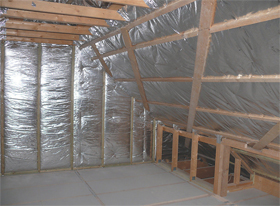Comparing Multifoil Loft Insulation and Fiberglass
Comparing Multifoil Loft Insulation and Fiberglass
When it comes to maintaining warmth and increasing energy efficiency in our houses, the key element is loft insulation. For a while, fiberglass has been the top choice for insulating lofts. However, a new competitor in the market is revolutionising the game – multifoil insulation. Let’s have a look into comparing multifoil loft insulation and fiberglass. Multifoil insulation is gaining popularity among homeowners and builders alike, with its numerous benefits that surpass traditional fiberglass for loft insulation, including products like YBS SuperQuilt and EcoQuilt Expert from Multifoil Insulation.
Comprehending the Fundamentals of Loft Insulation
Loft insulation serves as a barrier between the interior of your home and the outside environment. Its purpose is to prevent heat from escaping through the roof, which is essential to maintaining a warm and cosy indoor area. Without proper insulation, up to 25% of heat can be lost from a house. However, by installing insulation, you can effectively reduce heat loss, save on energy costs, and enhance the overall comfort of your living space.
Previously, loft insulation mainly used materials such as fiberglass and mineral wool. These substances work by capturing air within their fibres, creating a shield that impedes the flow of heat. While they have shown some level of efficacy, these traditional options have their limitations, including potential health risks, limited lifespan, and the need for thick layers to achieve optimal insulation.

Introducing Multifoil Insulation
Introducing Multifoil Insulation, a revolutionary product that is set to change the game in the insulation industry.
Multifoil insulation is a form of thermal insulation commonly utilised in building and renovation ventures to enhance energy effectiveness. It is composed of numerous levels of reflective materials, including aluminium foil, accompanied by wadding, foam, or an air-filled bubble layer. This structure effectively minimizes heat transfer via radiation, conduction, and convection, making it an effective method to maintain the warmth of buildings during colder seasons and keep them cool during hotter seasons. All in all, multifoil insulation is a versatile and efficient approach to improving the thermal efficiency of structures.
Understanding the Mechanism of Multifoil Insulation
Multifoil insulation is composed of multiple layers of foil that act as shields against radiant heat. This effectively retains warmth inside the house during the colder months and deflects it away during the warmer months. The insulation layers situated between the foil sheets provide additional defense against heat transfer, resulting in a highly efficient thermal barrier.
Advantages of Multifoil Insulation over Fiberglass
When examining the use of multifoil insulation versus fiberglass in loft installations, it is evident that the former offers numerous advantages. In this discourse, we shall explore the primary advantages that make multifoil insulation the superior choice for loft insulation.
Efficiency of Heat
Multifoil insulation is known for its exceptional thermal efficiency. Which can often exceed that of fiberglass, despite being a thinner product. Its ability to reflect radiant heat and low thermal conductivity makes it an effective barrier against heat loss.
Compact Design
The slim construction of multifoil insulation is a primary advantage. In comparison to fiberglass insulation, which typically requires thick layers for efficient insulation, multifoil can provide equal or better results with a much thinner layer. This efficient utilization of space is particularly beneficial in loft spaces where there is limited vertical room.
Ease of Installation and Versatility
Multifoil insulation offers great versatility and can fulfill various functions beyond its traditional use as loft insulation. It has a lightweight design, is flexible, and can be effortlessly trimmed and formed around any obstacles, greatly simplifying the installation process in contrast to the challenging task of handling fiberglass.
Longevity
Unlike fiberglass, multifoil insulation maintains its insulating properties without settling or weakening over time. It remains efficient for a prolonged period and is not susceptible to damage from moisture, mould, or pests. This ensures its durability and eliminates the need for frequent replacement or maintenance.
Safety and Wellbeing
Dealing with fiberglass insulation can pose a risk. Therefore it is essential to wear protective gear to avoid skin irritations and respiratory issues. On the other hand, multifoil insulation is a safer alternative that does not release harmful fibers. Making it a more beneficial option for both installers and homeowners in terms of health.
